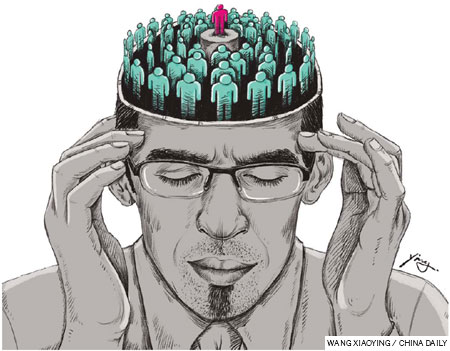Recognizing a SAD fact

Social anxiety disorder is a crippling shyness that makes its sufferers want to avoid being in large social settings. The nation is only now waking up to this growing concern. Guo Shuhan reports.
Before finally accepting a position as department head, Wu Ting turned down three promotion opportunities in the past 20 years just so she could avoid giving presentations at large gatherings.
Wu works for a State-owned corporation in Chengdu, capital of Sichuan province. Not long after joining the company, she was asked to convey to her colleagues the proceedings of a meeting that she had attended.
The then green hand was left speechless, unable to recollect anything from the meeting.
That was the start of Wu's fear of speaking in front of more than five people.
The psychological problem that has bothered Wu for two decades is known as social anxiety disorder (SAD), or social phobia, and is characterized by a distracting nervousness in large gatherings and a powerful desire to avoid such situations.
"I felt awkward and kept thinking I was not worthy," Wu told her doctor.
As a result, every time the 38-year-old was given new, higher responsibilities, she would apply for a transfer to another department, so she could work as a junior staff member.
The symptoms of SAD are often put down to shyness and hence the condition is still largely ignored in China, says Zhang Mingyuan, a doctor with Shanghai Mental Health Center.
Sufferers like Wu fear putting themselves through an evaluation by others, convinced that such assessment will be negative and embarrassing.
In most cases, the dread is either caused by self-contempt from an embarrassing experience like Wu's, or negative comments from those with whom the victim has significant social interactions, such as family members, teachers or colleagues.
Zhang adds that even seeing the doctor is distressing to those suffering from social phobia. Constrained by awkward feelings, they are inclined to avoid being diagnosed.
In December, 2010, the mental health center of West China Hospital of Sichuan University in Chengdu published the nation's first survey on SAD.
The survey, done over four years, covered 2,279 middle school and university students aged between 13 and 24, the typical age for the onset of SAD.
It showed that 8.15 percent of those surveyed had symptoms of SAD, with the highest incidence in those aged 19, with 11 percent of the respondents displaying its signs. "Such a high figure came as a shock," says Zhang Wei, vice president of the hospital, who was tasked with conducting the survey. He says the figure for other similar psychiatric disorders for this age group is around 0.1 percent.
Zhang has led more than 100 hospital employees in its mental health center to focus on SAD for the past 10 years. The center now offers treatment for some 40 to 50 patients a month, which has doubled from four years ago.
While there is no official figure of people suffering from SAD in China, an estimate given by Professor Zhang Xinkai, of the School of Medicine of Shanghai Jiaotong University, to China Newsweek puts the figure as "at least 30 million".
"The increase in the number of patients hints at a large group of sufferers," he says, adding that this may also reflect people's increasing awareness of the disorder.
He says that while being shy is normal, it is when the shyness interferes with an individual's daily communication with colleagues and others and becomes tortuous, that it becomes a disorder.
Patients coming to the center can be grouped into two age groups, 19 to 25, and 40 to 50, says Meng Jingya, a doctor at the mental health center of West China Hospital.
Meng says young patients, many of whom are senior high school and university graduates, often come to see the doctor with their parents. Most find it hard to adapt to the changes from high school to university, or to life after graduation.
Parents fail to cultivate the social skills of their children during their school years, as parents, teachers and society in general focus mainly on their academic performance, Meng says.
In a few cases, there is a genetic link, with the afflicted youngsters' parents also showing symptoms of SAD.
Those aged between 40 and 50 are often under heavy pressure from work, family and social relationships, and these may cause SAD.
The younger the age, the better the treatment's efficacy, Meng says. For most young patients, a 10-session group therapy over three months can produce marked results.
In mild cases, just one or two sessions of group therapy is all that is required.
Zhang Wei recalls how Wu Ting attended six therapy sessions and learnt relaxation techniques, besides rehearsing presentations. She finally succeeded in facing her supervisors to detail her accomplishments.
But for those suffering from severe symptoms, medication may be necessary, Meng says. They may also have to be put through further individual therapy, he adds.
Despite the growing attention to SAD, there are not enough qualified medical personnel to help SAD sufferers, says Zhang Mingyuan, the Shanghai doctor.
Since 2003, the mental health center of West China Hospital has trained some 4,000 psychological counselors from all over the country.
But only half of them have the necessary qualifications to be certified a psychological counselor. And only some 10 percent of those certified are competent enough to provide an effective treatment, Zhang Wei says.
In 2010, the center carried out another survey of more than 3,000 children, aged between 6 and 12, in Chengdu. Less than 1 percent were found to be afflicted with SAD.
"This result shows that helping children drum up courage at an early age can prevent their lives being taken over by SAD later," Zhang Wei says.
"Parents, teachers and others should provide more affirmative assessments. If negative comments are really necessary, children must be told the reasons behind them and shown ways to improve."
(China Daily 03/16/2011 page18)






















